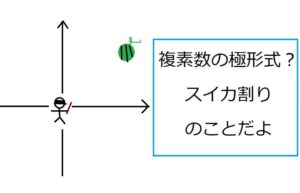高校数学で最も美しい定理(マスタノ調べ)である
ド・モアブルの定理を今回は証明します。
どうやって証明するのか、なぜその発想に至るのか。
思考過程も含めて丁寧に分かりやすく解説していきます!
ド・モアブルの定理を発見するまで
定理を発見するまでの道筋はいつだって観察から始まります。
ド・モアブルの定理は何を観察して見つかったかというと、
複素数の掛け算です。
前回の記事で、複素数の極形式を学びました。
$a+bi=\sqrt{a^2+b^2}(\cos \theta +i\sin \theta)$
複素数は2通りの表し方があり、右辺の表し方のことを極形式と呼びます。
極形式に馴染みのない方は以下をご参照ください

今回は、一番シンプルな極形式を考えます。
すなわち、
$\cos\theta +i\sin \theta$
を考えます。複素数平面の単位円上の点です。
これを、掛け算していきます。
まずは二乗。
$(\cos \theta +i\sin \theta)^2=\cos^2\theta+2i\cos\theta \sin \theta+i^2\sin^2\theta$
$=(\cos^2\theta -\sin^2 \theta)+(2\sin \theta \cos \theta)i$
これを見て何かを思い出しませんか?
→三角関数の倍角の公式です!!
$\cos 2\theta =\cos^2\theta-\sin^2\theta$と
$\sin 2\theta=2\sin\theta \cos\theta$
を代入すると、
$(\cos \theta+i\sin \theta)^2=\cos 2\theta+i\sin 2\theta$
が成立します!!
何か神秘を感じませんか?
これが偶然か、必然か。
確かめたくなるのが数学を愛する者の定めです。
続き、すなわち、三乗の場合を考えてみましょう!
$(\cos \theta +i\sin \theta)^3=(\cos \theta+i\sin \theta)^2(\cos \theta+i\sin \theta)$
$=(\cos 2\theta +i\sin 2\theta)(\cos \theta+i\sin \theta)$
$=\cos 2\theta \cos \theta +i\cos 2\theta\sin \theta+i\sin2\theta\cos \theta +i^2\sin 2\theta \sin \theta$
$=(\cos 2\theta \cos\theta-\sin 2\theta\sin\theta)+(\sin 2\theta \cos\theta+\cos 2\theta \sin \theta)i\cdots①$
ここで、コサインとサインの加法定理を思い出しておきましょう
$\cos (\alpha +\beta)=\cos \alpha \cos\beta -\sin \alpha \sin \beta$
$\sin (\alpha +\beta)=\sin \alpha \cos \beta +\cos \alpha \sin \beta$
これに$\alpha =2\theta, \beta=\theta$を代入すると、
$\cos (2\theta +\theta)=\cos 2\theta \cos \theta -\sin 2\theta \sin \theta$
$\sin (2\theta +\theta)=\sin 2\theta \cos \theta +\cos 2\theta \cos \theta$
となります。
これらを①に代入すると、
$(\cos \theta +i\sin \theta)^3=\cos 3\theta +i\sin 3\theta$
が成り立ちます。
ヤバくないですか??
ここまで観察してきた内容から、以下の規則性が成り立つと予想できます。
$n$を自然数とすると、
$(\cos \theta +i\sin \theta)^n=\cos n\theta +i\sin n\theta$
これがド・モアブルの定理(自然数バージョン)です。
今はまだ観察で導かれた予想なので、これから証明していきます。
ド・モアブルの定理の証明
$n$を自然数とすると、
$(\cos \theta +i\sin \theta)^n=\cos n\theta +i\sin n\theta$
が成り立つ。
~脳内会議~
定理の証明の際、条件と結果を分けて考えることが非常に大切です。
今回は、緑マーカーが条件で、黄色マーカーが結果です。
今回条件から読み取るべきこととしては、
あ、これ、自然数についての証明だな、ということです。
選択肢として、
自然数+証明=数学的帰納法
が成り立ちますので(マスタノ調べ)、今回は$n$についての帰納法で示していきます。
補足:数学的帰納法を用いる場合は、
何の文字に着目しているかが結構重要になりますので、
留意しておきましょう。今回は$n$に着目しています。
(証明)
$n$が自然数であるとき、
$(\cos \theta +i\sin \theta)^n=\cos n\theta +i\sin n\theta\cdots ㋐$
が成り立つことを数学的帰納法で示す。
$Ⅰ)$ $n=1$のとき
$(\cos \theta +i\sin \theta)^1=\cos \theta +i\sin \theta$
が成立。
よって、$n=1$の際は㋐は成立する。$\cdots ㋑$
$Ⅱ)$ $n=k$の時に㋐が成り立つと仮定して、$n=k+1$でも㋐が成り立つことを示す。
$(\cos \theta +i\sin \theta)^{k+1}=\cos (k+1)\theta +i\sin (k+1)\theta$
が成立すればよい。
いま、
$(\cos \theta +i\sin \theta)^{k+1}=(\cos \theta +i\sin \theta)^k(\cos \theta +i\sin \theta)$
である。
ここで、仮定より、
$(\cos \theta +i\sin \theta)^k=\cos k\theta +i\sin k\theta$
が成り立つので、
$(\cos \theta +i\sin \theta)^{k+1}=(\cos k\theta +i\sin k\theta)(\cos \theta +i\sin \theta)$
$=(\cos k\theta \cos \theta-\sin k\theta \sin \theta)+(\sin k\theta \cos \theta +\cos k\theta \sin \theta)i$
今、加法定理
$\cos (\alpha +\beta)=\cos \alpha \cos\beta -\sin \alpha \sin \beta$
$\sin (\alpha +\beta)=\sin \alpha \cos \beta +\cos \alpha \sin \beta$
に$\alpha=k\theta, \beta=\theta$を代入すると、
$\cos (k+1)\theta=\cos k\theta \cos\theta -\sin k\theta \sin \theta$
$\sin (k+1)\theta =\sin k\theta \cos \theta +\cos k\theta \sin \theta$
が成立するので、
$(\cos \theta +i\sin \theta)^{k+1}=\cos (k+1)\theta +i\sin (k+1)\theta$
となり、㋐は$n=k+1$でも成立$\cdots ㋒$
㋑、㋒より、数学的帰納法から、全ての自然数$n$について、
$(\cos \theta +i\sin \theta)^n=\cos n\theta +i\sin n\theta$
が成立する
(証明終了)
いやはや、感動的です。
で、実はまだ続きがあると言ったら驚くでしょうか。
ド・モアブルの定理は、$n$が自然数の場合のみならず、整数全体で成立するのです!
つまり、$n=-3$とかでも成立する定理なのです!
このように、定理を拡張していくことは数学でよくあります。
おまけで、$n$が負数の場合のド・モアブルの定理も証明しておきます。
おまけなので、読み飛ばしてまとめにいってもOKです!
($n$が負数の場合の証明)
$n$を負数として、
$(\cos \theta +i\sin \theta)^n=\cos n\theta +i\sin n\theta$
を示す。
$n$は負の整数であるので、ある正の整数$m$をとって、
$n=-m$と表すことができる。←$-3=-1×3$みたいなもんと思ってください
$(\cos \theta +i\sin \theta)^n=(\cos \theta +i\sin \theta)^{-m}$
$=\dfrac{1}{(\cos \theta +\sin \theta)^m}$
である。ここで、$m$は正の整数であるので、
$(\cos \theta +i\sin \theta)^m=\cos m\theta +i\sin m\theta$
である。これを代入すると、
$(\cos \theta +i\sin \theta)^n=\dfrac{1}{\cos m\theta +i\sin m\theta}$
となる。
右辺について、分子分母に$\cos m\theta -i\sin m\theta$をかける。
$\dfrac{1×(\cos m\theta -i\sin m\theta)}{(\cos m\theta +i\sin m\theta)(\cos m\theta -i\sin m\theta)}=\dfrac{\cos m\theta -\sin m\theta}{\cos^2m\theta-i^2\sin^2m\theta}$
$=\dfrac{\cos m\theta -\sin m\theta}{\cos^2m\theta +\sin^2 m\theta}$
$=\cos m\theta -i\sin m\theta$
となる。
ここで、三角関数の性質より、
$\cos (-m\theta)=\cos m\theta$
$\sin (-m\theta)=-\sin m\theta$
であったので、これらを代入すると、
$(\cos \theta +i\sin \theta)^n=\cos (-m)\theta +i\sin (-m)\theta$
となり、$n=-m$であったので、
$(\cos \theta +i\sin \theta)^n=\cos n\theta +i\sin n\theta $
となる。よって、$n$が負数の場合でもド・モアブルの定理は成立する
(証明終了)
まとめ
いかがでしたか?
今回は数学的帰納法を用いてド・モアブルの定理を証明しました。
・$(\cos \theta +i\sin \theta)^n=\cos n\theta +i\sin n\theta$
・ド・モアブルの定理は$n$があらゆる整数の場合でも成立
を押さえていただければと思います。
証明方法は実は色々あるのですが、
観察・規則性を発見・証明といった数学を研究する楽しさが一番味わえるのは
圧倒的に帰納法による証明ですので、
今回の記事ではこういった形でド・モアブルの定理を証明しました。
オイラーの公式を用いた証明も中々エレガントなので、後々記事にしようと思います。
ご期待ください。
ではまた次の記事でお会いしましょう!

コメント